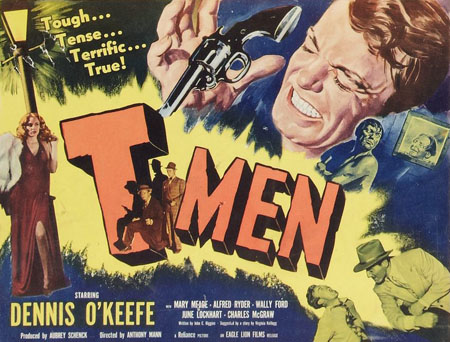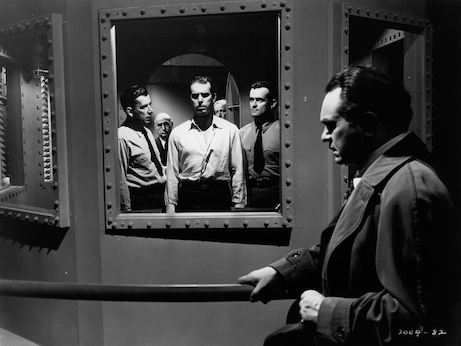by Paul Batters

‘How could I know that murder can sometimes smell like honeysuckle?’ Walter Neff (Fred MacMurray) Double Indemnity (1944)
In any society, murder is the most horrendous crime. It is a betrayal of trust, goes against the concept of a safe and secure society and steals the greatest gift that any human has – life itself. As a result, society demands justice when murder is perpetrated and indeed, even vengeance for such a transgression. In a modern, ordered and civilised world, that justice is processed through a legal system. In film noir, murder is a normal part of its dark and twisted world. In film noir, business partnerships aren’t dissolved by being bought out or through a legal process. Lovers or spouses don’t break up or get sent a ‘Dear John’ letter. People cheated out of money don’t get a visit from the police or face a civil suit. Those who have transgressed in any way are not dealt with in the usual ways. In the world of film noir, all are dealt with using a .38.
In the pantheon of film noir, murder is an ever-present trope because it is the ultimate crime. The characters who walk the streets of the film noir universe know it is present and even expect it to come their way. Having written previously on Death As Redemption In Film Noir, there are those who even welcome murder as a reprieve from the pains and sufferings of the world, or in particular as justice for their own indiscretions and crimes. The aptly named The Killers (1946) is a perfect example of the ever-presence of murder as a trope in film noir. Murder is the key tool used by professional hitmen, with their initial target Ole Anderson (Burt Lancaster), the key target. Interestingly, Anderson, after becoming aware that two professional hitmen are seeking him out, makes no attempt to escape or dodge his fate. He accepts what is going to come and acknowledges that his death is a form of redemption, and that murder is par for the course of a life of crime.


To describe murder in film noir as an occupational hazard, sounds like an understatement as well as a cliché. Yet it is not only an occupational hazard but a tool of the trade for the gangsters, hoodlums and killers that stalk the streets, occupy the cheap bars and hide in shadowy alleys in the world of film noir. The quintessential heist film and a sterling film which exemplifies this is John Huston’s The Asphalt Jungle (1950). Focused on a diamond robbery put together by ‘Doc’ Riedenschneider (Sam Jaffe), violence is an integral part of the preparation for the heist. Doc recognises that the need for a hoodlum willing to commit violence is as integral as a reliable wheelman and a top-notch safe cracker. Dix Handley (Sterling Hayden) is the man they need and whilst not a killer, he is a man that will use violence where necessary. Complications with the heist and a double-cross from the heist’s financial backer, corrupt lawyer, Alonzo D. Emmerich (Louis Calhern), sees that violence become a necessity. Whilst not strictly cold-blooded murder, Dix shoots and kills Bob Brannom (Brad Dexter) during the double-cross. It is a situation where the threat of murder is part of the business bargaining and an underlying reality to the dealings in the criminal world.
The same threat of menace and danger which pre-empts murder and death is as present for those working the legal side of the fence. This is especially evident in Anthony Mann’s T-Men (1947). The threat of murder is forever present as two U.S Treasury agents go undercover to infiltrate and bring down a counterfeit gang. In one particularly brutal scene, Moxy disposes of one of the gangsters by cooking him alive in a steam-room. It certainly gives new meaning to turning up the heat. With its brilliant use of deep black and stark lighting, the oppressive sense of violence is heightened and the sense of panic and terror likewise in the moments before death. To protect their business interests, murder is a powerful tool and one which in the world of film noir could be visited upon anyone. Likewise, the private detective, the knight in dented armour, is also more than aware that murder is a reality in his or her world. They certainly spend a great deal of their time investigating it and likewise avoiding it. The ‘gumshoe’ or ‘shamus’ walks a difficult line; they seek truth and justice yet are not part of the police. At times, they drift into illegalities and do not have the legal protections that are afforded the authorities. Indeed, they often annoy and irritate the authorities who see them as obstacles. As evident in The Maltese Falcon (1941) and Murder, My Sweet (1944), the dangers of murder are always around the corner. To avoid it, they work by their wits and experience.



But murder in film noir is not merely an occupational hazard, it becomes a way of solving problems and removing obstacles. In John Stahl’s brilliant Leave Her To Heaven (1945), writer Richard Harland (Cornel Wilde) marries socialite Ellen (Gene Tierney). Her obsessive and jealous nature is at first passed off by Richard as simply a love that is too strong. However, Ellen looks for ways in which she can isolate Richard from anyone she sees as a threat, including his family. In one of the most horrific scenes on film, Ellen encourages Richard’s younger, crippled brother Danny (Darryl Hickman) to swim deeper into the nearby lake, as she follows him in a rowboat. She watches as he struggles and lets him drown as he begs for help. Passed off as an accident, Ellen initially seems to have gotten away with murder and she has managed to remove what she deems to be an obstacle in her path to have all of Danny’s love and devotion. In Sorry, Wrong Number (1948), Henry J. Stephenson (Burt Lancaster) arranges the murder of his wife Leona (Barbara Stanwyck) to pay off his debts to gangsters. Stephenson sees murder as the only way to solving his problems and getting out of the mess that he has created. Likewise, in Billy Wilder’s Double Indemnity (1944), insurance salesman Walter Neff (Fred MacMurray) sees murder as the only way to extricate himself and ‘get off the trolley car’, from the mess he has gotten himself into; ironically after himself committing murder for femme fatale Phyllis Dietrichson (Barbara Stanwyck). He will finally realise that Phyllis intends to use murder to get rid of him as well. After all, he is not only a liability to her but he is no longer of any use to her.
Which brings us to the femme fatale, perhaps one of the most recognised characters in film noir. We’ve already had a brief look at two and it’s already noted that murder is a modus operandi for the femme fatale. Either they are murderers themselves or entice and seduce others to commit murder for them; whatever the reason. Two of the finest examples of the femme fatale are present in two films that this writer feels are two of the best example of film noir, particularly from the 1940s: Double Indemnity (1944) and Out Of The Past (1947). In Double Indemnity, the aforementioned Phyllis Dietrichson (Barbara Stanwyck) is a cold and despicable femme fatale. As Walter Neff discovers, Phyllis uses murder in numerous ways, either enticing others (like himself) to kill or to commit murder herself. In Out Of The Past (1947), Kathie Moffat (Jane Greer) is likewise a cold and despicable woman, who betrays the men in her life. Murder is also an MO for Kathie, and she has no problem using murder to get her way, let alone throwing someone under the bus to save her skin. In. both cases, the fatal mistake that men make is that they fall in love (or lust, to be more cynical). Neff is dazzled at first sight and through a fatalist lens declares that he knew he would fall further for her. Indeed, Neff will suggest that he never knew ‘that murder could sometimes smell like honeysuckle’. The beauty, warmth and scent of the Spanish-style Dietrichson home on the outside hides the moribund, dusty and mundane interior. Phyllis, likewise, is beautiful on the outside but dead with corruption on the inside. Likewise, Jeff (Robert Mitchum) falls in love with Kathie and can understand why Whit (Kirk Douglas) does as well, even forgiving her double-crossing: ‘And then I saw her, coming out of the sun, and I knew why Whit didn’t care about that 40 grand’. It is the perfect line to describe the allure of the femme fatale, and how she can secure a man to commit murder for her.


As part of the audience, we all shake our heads in disbelief that these people would think that murder would get them out of trouble. It’s easy to ask the question – what makes them think they will get away with it? Yet the answer is clear. They all think they can buck the system and that they will not get caught. No-one, including the audience after leaving the theatre (or in this new brave world, turning off the wide-screen smart TV) can say that they have not fantasised about beating the system, breaking a mundane and boring life or ached to fulfil a desire that we know we cannot fulfil. The difference of course is that in the real world, the audience (mostly) is driven by values, morals, ethics, laws, fears etc to keep the law and steer the course of ‘normal’, mundane lives. In film noir, the audience seems characters make an ‘existential choice’, as Robert Porfirio suggests where the mundane is rejected for authenticity and that means freedom embodied in ‘sex, money, power and the promise of adventure’. However, as the characters in film noir discover, the attainment of these things stepping into the darkness and that often means murder. After all, in the world of film noir, murder and death are the norms.
This article is a proud entry into the CMBA Fall 2022 Blogathon – Movies Are Murder. Please visit to read some fantastic articles from great writers on classic film. Please remember to like, share and leave your comments – it’s important to respect, honour and support the work!

Paul Batters teaches secondary school History in the Illawarra region and also lectures at the University Of Wollongong. In a previous life, he was involved in community radio and independent publications. Looking to a career in writing, Paul also has a passion for film history.







You must be logged in to post a comment.